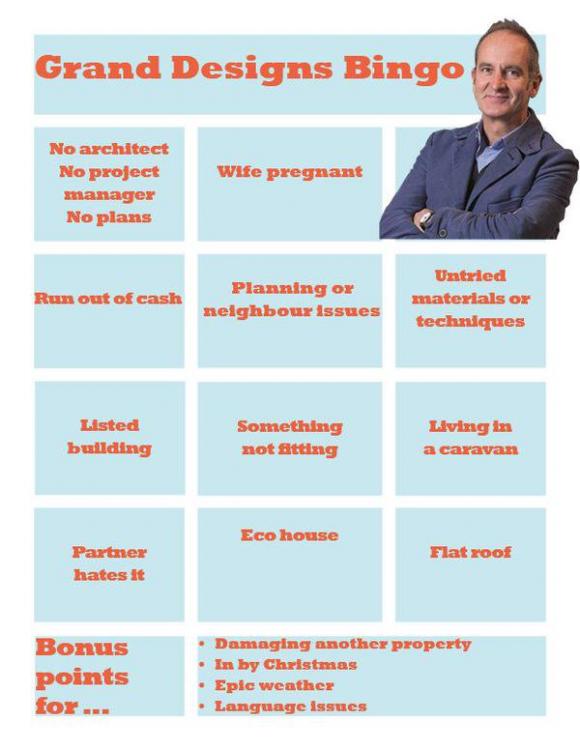Leaderboard
Popular Content
Showing content with the highest reputation on 09/05/17 in all areas
-
At the end of the last episode, we were the proud owners of a landlocked, overlooked, overgrown plot in the centre of a medieval conservation area. Easy to develop, right? The plot was accessed through a narrow close, about 2cm too narrow for a transit (even with the mirrors folded and a brave/careless driver in charge), so completely impractical for the creation of a new house. On either side, the plot is overlooked by 3 storey blocks of flats, tight up against the boundary, and at the rear, by a selection of very attractive 50's, harled, concrete panel lock up garages. There are 8 of these that back onto the plot. So, to cut a long story short, we ended up having to buy 2 of these garages, pay extensive lawyers fees, carefully take them apart and store the bits to allow us proper access to the site. They were not cheap. They were so not cheap that we couldn't afford to knock them down - we're going to put them carefully back together when we're finished and sell them to recoup some cash. The plot, as it stands, consists of two traditional Scottish rigs, covered in a LOT of topsoil, ivy, an old timber shed and a million old paving slabs. Hopefully no Viking longships or bodies. The space itself is very tight, limited in the height we can build to and with lots of overlooking/privacy issues. Our architect came up with an initial plan of an L shaped building, overlooking our own courtyard garden with no windows on either side gable to avoid privacy issues. We liked the design - the planners liked it, our neighbours and various local groups very much didn't. We had numerous objections including "inappropriate use of modern materials" (newfangled wood/glass), "destruction of the rig structure" (it was abandoned waste ground and had been garden or pasture since pretty much the founding of the town) and so many others that I can't even remember them all. We had to go to planning committee, where we were advised that it simply wouldn't be approved with a flat roof design, so back to the drawing board we go. We end up with a quite compromised design, three stories and with all the complexities that brings. No-one was very happy. We passed committee and got our planning. So, to building warrant stage we go - back and forth between various build methods, SIP being the front runner for a long time. Numerous engineers, foundation meetings, quotes and drama, we end up with a building warrant package ready to go. The DAY before submitting the package to building control, we heard the news that we could potentially obtain some land next to our plot boundary, and improve the vehicle access. After tears of frustration and chucking away all the work the architect had done, we realised that actually it was a stroke of luck and we could radically improve the design, the floorplan, the access AND the garden area. Never mind all the work already done and the time spent .... BACK to the drawing board, AND planning, all over again.4 points
-
I'm sticking this here as I've been asked the question via PM, and rather than just give an answer to one member, I thought it might be more useful to stick the answer somewhere were others can also read it. Back when I was first looking at doing some rough "what if" type comparisons, between different build systems, windows, insulation and airtightness levels etc, I wanted a fairly quick way to be able to change one element, say the wall U value, or the efficiency of the MVHR system, and see what impact it had on the overall heat loss of the house. This model was never intended as a substitute for something like PHPP, which is very comprehensive, it was just intended to give a rough idea so that I could see the scale of some of the changes, and work out where best to spend our limited budget. Having written the spreadsheet for our build, others expressed interest in using it, so I tidied it up and let others have a copy. Because lots of people seemed to want to use it, and also because it generally seemed to give results that were within 10% or so of more complex models, like PHPP, I put a copy of the spreadsheet up on our website, as a free download: http://www.mayfly.eu/wp-content/uploads/2017/01/Fabric-and-ventilation-heat-loss-calculator-Master.xls This post is a set of very brief instructions on using this spreadsheet. First some health warnings. It was never intended to give an absolutely accurate prediction of heat loss, and as such it takes no account of solar gain, wind or incidental heat gain from occupants and appliances. As a consequence it is generally a bit pessimistic, in that it will usually tend to slightly overestimate the heating requirement. This is not necessarily a bad thing, as it can be useful to have a bit of heating capacity in reserve for exceptionally cold weather. To use the spreadsheet, you first need to gather all the data needed to complete the white cells. Most of this should be self-explanatory from the notes in each section. The U values, for example, should be the true U value of the component, including any additional thermal paths, so the window U value needs to be the Uw value, not the Ug value, and the floor U value needs to be adjusted for any thermal bridging around the periphery. All the areas are the internal wall, floor and ceiling/roof areas, not the external ones. The model does not account for geometric thermal bridging at corners, but in a well-insulated house this effect should be very small, anyway. Some of the most difficult to obtain data can be the mean daily air temperature and the mean minimum daily temperature, for each month. This data is available for your location on the Met Office website, but posting a link seems a bit fraught, as the Met Office keep changing their website and this makes any link out of date fairly quickly. All I can suggest is that you work your way through the historic data on the Met Office website and find that closest to where you live. Once all the data is filled into the white cells on the spreadsheet, you should get some numerical data in the green cells, plus two graphs will appear. The graphical data is often the most useful. First, there is a basic heat loss versus outside air temperature plot (the Heat Loss Vs Delta T plot). You can use this to determine how much heat the house will need to maintain the room temperature that you put into the spreadsheet (it defaults to 20 deg C, but you can change this to whatever you feel comfortable with). The red line is the total heat loss, the other lines are there so you can see which elements are contributing the most to the total. If you want to know how much heat the house will need in order to maintain a temperature difference between inside and outside of 20 deg C (say a 20 deg C room temperature when it's zero deg C outside), then just go up vertically from the 20 deg C point on the horizontal axis until it meets the red line, then go across horizontally from this point to the vertical axis and read off the heating needed in watts. The other plot shows the heat loss per month, and this one can be a bit confusing, because, like the other plot, it takes no account of incidental heat gain, from solar heating, appliances, occupants etc. The best way to use this is to print it off and pencil a horizontal line across where you think you wouldn't have heating on. For example, If you turn your heating off in April/May and on again in September/October, then draw lines across at about the point where these dates cross the other lines and call that your "no heating" point. The mean heating needed for each month will then be the difference between those lines and the values on the plots. You can quickly work this out by just noting the amount of incidental heat gain, indicated by the pencilled horizontal lines, and then subtracting those values from the monthly values. Be aware that this is really a very rough estimating tool, as there will be big peaks and troughs in daily temperatures within those months that will effect the heating required. In most respects, the heat loss vs delta T plot is more useful for sizing a heating system. Hopefully the above should make some sense to anyone trying to use this tool.3 points
-
3 points
-
Oooh a new series. I wonder how many women folk he will get pregnant in this series? He should give up building houses and try fertility, the blokes a bloody god2 points
-
Top and bottom of most self-builds are decisions, decisions and can we afford it, Full stop!!!!2 points
-
Thus spake the Phoenix from the flames that engulfed Ice Energy... 10.18 pence/kWh…will apply to all new RHI registrations and anybody who registered for the RHI on or after 14th December 2016 will have their payments automatically uplifted (anybody who registered for the RHI prior to that date will remain on their pre-existing tariff). … Full details of the announcement can be found on the Ofgem website.1 point
-
Another day another dollar well £50 million if you are Kevin mcCloud. You cannot help but applauding his drive and wish him well with this venture but you need to be knowledgeable investor and its a risk but at least it might move things forward. On the other end of the scale your man from Redrow mentioned on the Today programme this morning that once brexit brings the flow of EU tradesmen to a stop building in London and the SE will also stop. Perhaps if instead of short term profit they should have invested in making 'trades' sexy and lucrative for bright kids who don't want 'pure brain / talking work' and then offered them an apprenticeship and then paid them well. The levy was never big enough to allow the CiTB to get any traction in schools and across a society, establishment, that has driven a wedge into our society around a degree for one half of the population and not provided a positive image for trades on the other side for which there is clearly a demand - some body get a grip. Rant over.1 point
-
Had a similar scenario where my concrete/screed layer was going to be above my sole plate. I was simply going to ensure that my DPM lapped up against the side the sole plate and up the OSB wall. Don't forget the perimeter insulation. In the end I went with a mix of PIR and EPS so my floor is going to end up level with the blocks that my SIPs sit on. Also consider cold bridging around this area and how to minimise. As for vacuum panels, aren't they prone to losing the vacuum over time? And also bloody £££?1 point
-
The top of the form... https://ecab.planningportal.co.uk/uploads/1app/forms/form_7_self_build_part_1_exemption_claim.pdf I don't think the CIL legislation defines Commencement of work but for Planning purposes there is a definition in the Town and Country Planning Act section 56.. http://www.legislation.gov.uk/ukpga/1990/8/section/56 So you might be ok clearing tree but personally I wouldn't give them any excuse. http://www.wslaw.co.uk/knowledge-centre/newsletter/article/176/commencement-of-development-practical-tips-and-pitfalls1 point
-
If you can get better than 4.8% then why is everybody not doing it. I suspect because it's not regulated, we perhaps have not adjusted our ROI meters back a sensible return over a slightly increased period to allow a business to florish and we have forgotten that if a thing looks to good to be true then it probably is to good to be true .1 point
-
If you watch the programme, then very often an unexpected pregnancy occurs part way through the build. It's happened enough times as to have been remarked on by a fair few people!1 point
-
So true! This bit was horrible - thankfully we are on site now, so I'm writing up history I'll eventually catch up to where we are at the minute!1 point
-
You know Mike, joking apart, that's not a bad idea!1 point
-
Come Wednesday commeth 'da man' again as the new series of Grand designs starts. I have no doubt we will chew it over here. It does seem that Kevin can be a bit short sighted in not controlling the message in enough detail, while being so far sighted as to want to sort out our housing crisis - well a corner of it anyway. @JSHarris has pointed out that he should probably not try to compete with the big housebuilders - dead right they are truly awful so one might argue that anything, albeit somewhat flawed, has to be a step in the right direction. What he, Kevin, needs is help - not cash but genuine support in trying new ways forward. I have a good mind to write to him, point out build hub and get him some help.1 point
-
Well, after being told the electricity connection process was "with wayleave dept." I spoke to the guy who owns the land our connection has to come 1 metre through - he is absolutely fine about it, but confirmed last night that no one has been in touch with him! So posted this on NorthernNetworks Facebook page again last night and surprise surprise I got a call today from an apologetic lady saying she works in wayleave and only received the job last night. You really have to wonder how firms can get so bad at what they do - I mean you'd really have to go out of your way to be this bad! It takes dedication and a lot of effort. Anyway, on the plus side, I took a day off work today as I'm expecting several deliveries and by sheer chance the building inspector rang and said could he come and take a look at the roof today. So that was great timing and he's more than happy with it and commented on how good the standard of work is. We are pleased too and a nearby roof has also been done recently and even with a laymans eye you can see that our guys work is better. We are really pleased with the roof - it's done with recycled slates, and as we'd hoped, looks the part (it's in a rural Northumberland village) already as if it's been there years. Only the neatness of the lines gives away that bits new. Today I am putting the DPM and floor insulation down on the utility and downstairs bathroom floors with the intention of doing them first so we can get the washing machine etc in and have a shower and loo ASAP. The UFH kit is due to all arrive today, so hopefully we might get that down before the weekend in those rooms, though the utility room is where the manifold will live so the pipework there is a little involved so I'll need to be sure its right before I concrete it!.1 point
-
Reminder: Make sure you get your CIL exemption paperwork done before starting any work on site.1 point
-
1 point
-
Any chance of adding in the additional functionality a la here..?? http://processheatingservices.com/water-heating-time-calculator/ Really useful to be able to work through the ideas of how long the immersions need to run etc1 point
-
I've said it before, but our plumber was aghast at the idea of a 5kW ASHP for a large house - and that was just for heating! He simply wouldn't believe there was any chance it could handle both DHW and heating. He gave an example of the DHW being on for a couple of hours very early in the morning, and wanted to know how we'd feel about the temperature in the house falling significantly during that period. I pointed out that it would take 24 hours without heat for there to be much difference to the temperature, so a couple of hours was nothing. He still refused to believe me and suggested a 9kW ASHP (he wanted 14kW) as a compromise. We went with the 5kW and it works just fine.1 point
-
You will have to explain (with a picture?) for those of us that don't know, what "two traditional Scottish rigs" are please. (I am sure you are not talking of the type found floating in the Cromarty Firth)1 point
-
1 point
-
1 point
-
Probably around £4k reduction if we block those weeks. Alternative could be to give reduced rental price with warning about potential noise. Triple glazing better for sound proofing?1 point
-
How much will your rental income be reduced by for those 2-3 weeks per year due to a temporary noisy environment ? £500-£1000 per annum? Or a lot more? Are the works justified?1 point
-
Cheap Wood burning stove. You have to be quick, not much time left on this offer price (will be interesting to see how much it goes up by when the offer ends) https://www.woodburnerworld.co.uk/kresnik-multifuel-woodburning-stove-45kw-13612-401468 I have ordered one and will be collecting it on a trip south in a few weeks. I am not suggesting it for a passive house but the one I am buying is to go in our static caravan.1 point
-
So you're getting noise from the open door and the blower cage - you need a way of : - Ducting the air into the fan from a baffled source - stopping noise being transmitted across the yard. First one could be as simple as blocking the doorway up and using some big galvanised square ducting to go up and over the fan house roof. Square duct is easier to cover with foam or fibre to also muffle the sound. Second thing is to build a fairly heavy wall about 6ft from the fan house to deflect the noise back away from the house. Sometimes easier to get the pre-made acoustic panels they use on roadsides - you can work out where it works best then by moving it about. Its not a permanent noise source so you need to weigh up cost vs benefit anyway - decent sound insulation in the house would be a good start !1 point
-
After the meter it's you and your GSRd fitters responsibility ?1 point
-
Well not that hard really, just wish I had better eyesight and I would spot the mistakes. Now let us see if I have managed to load it to 'somewhere' and it works. https://steamytea.wixsite.com/watercalculator1 point
-
Can't you just have a default message to say, "Update your browser dickhead" Is there any non javascript way to do it? I know next to nothing about coding, it is all a bit messy to me. But the arithmetic behind it is simple enough.1 point
-
Getting services installed does seem to be one of the biggest hold ups when self building. what a shame that companies cannot just get on a do their job efficiently!1 point
-
Only stuff we bought from TP was the Marley Cedral Click as they were close to 15% cheaper than the nearest competitor's price.1 point
This leaderboard is set to London/GMT+01:00








.jpg.c21f3ac78c9b7efd90cbdcb312744dc5.thumb.jpg.7adcad4c0e384f5ecd7d56b0618df6e5.jpg)





